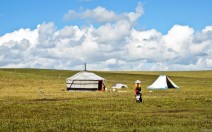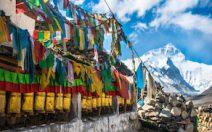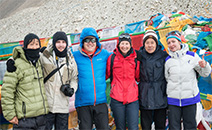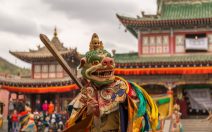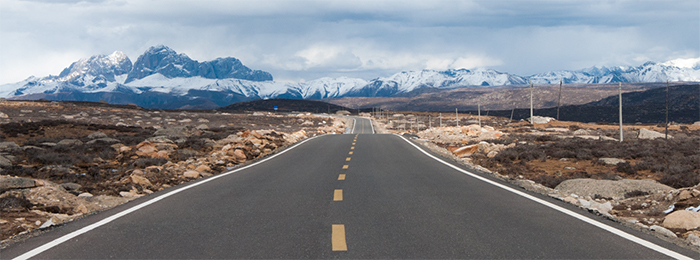Almost whole Tibet is located at great heights over the sea level. At the same height as Tibetan cities Lhasa and Shigatse in Alps, Caucasus and Central Asia there are icy peaks. Almost any city in the world, even mountain resorts are situated much lower. Therefore a trip to Tibet is an unusual experience even for athletes and mountain climbers, and even more so for people who live on the plain. Nevertheless, as long as everything is organized reasonably, ordinary people are able to adapt to these heights, but not immediately and with certain precautions.
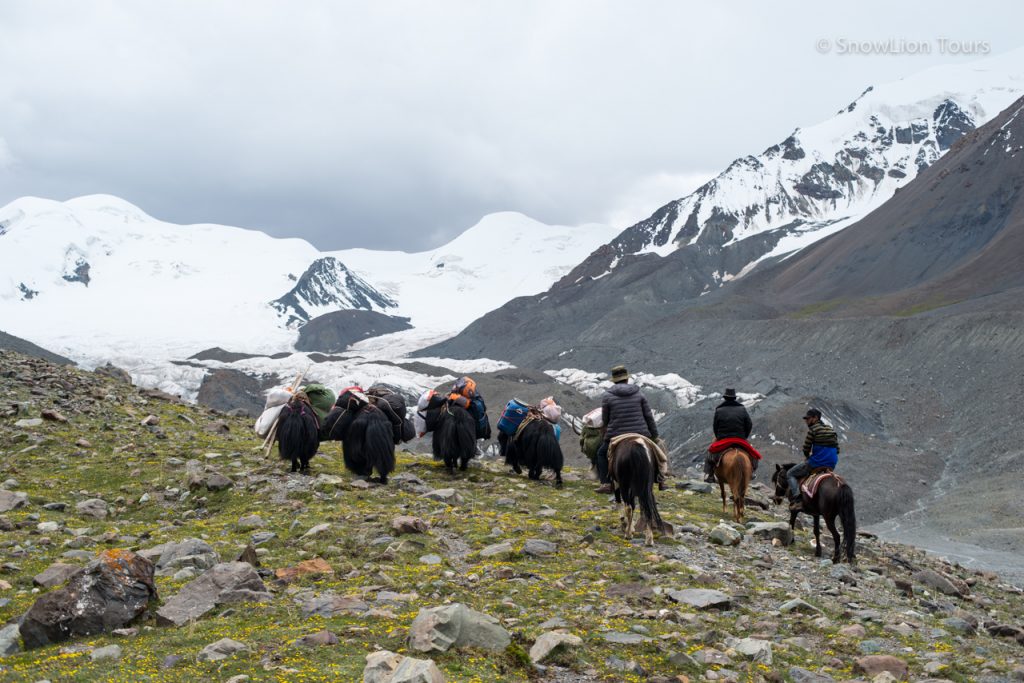
Yaks carrying luggages in an altitude of 5090m in one of our Mt. Amnye Machen Trekking Tours.
Completely safe zone borderline zone where air pressure is same as inside the airplane is at 2400 meters, and not only healthy adults but also infants and the elderly fly without any health risks. Starting approximately at 2700 meters requires acclimatization, and that’s any place in Tibet.
Heights in Tibet and other places
|
|
|
New York City (5m) |
Acclimatization is not needed |
|
Xining (2270m) |
↔ |
Mexico City (2240m) |
|
|
Lhasa (3600m) |
↔ |
Wetterhorn, Swiss Alps (3701m) |
Acclimatization is needed |
|
Shigatse (3800m) |
↔ |
Mount Elbrus, topmost height of gondola lift (3780m) |
|
|
Darchen, start of track around Kailas (4600 m) |
↔ |
Dufourspitze, Swiss Alps (4634m) |
|
|
Highest point of the railroad to Lhasa (5072m) |
↔ |
Mount Kazbek, Caucasus (5047m) |
|
|
Everest Base Camp (5150m) |
↔ |
Mount Ararat (5137m) |
Mountain sickness and acclimatization. What happens to a person at great heights
Air pressure at the top of the mountain is less than at the bottom. One cubic meter of air at sea level contains 1.3 kilos of oxygen, at 2500 meters 1 kilo (75%), at 4300 meters 780 grams (60%), and at 5600 meters only 650 grams (50%). Content of other gases is also lower, but it is not critical for human body.
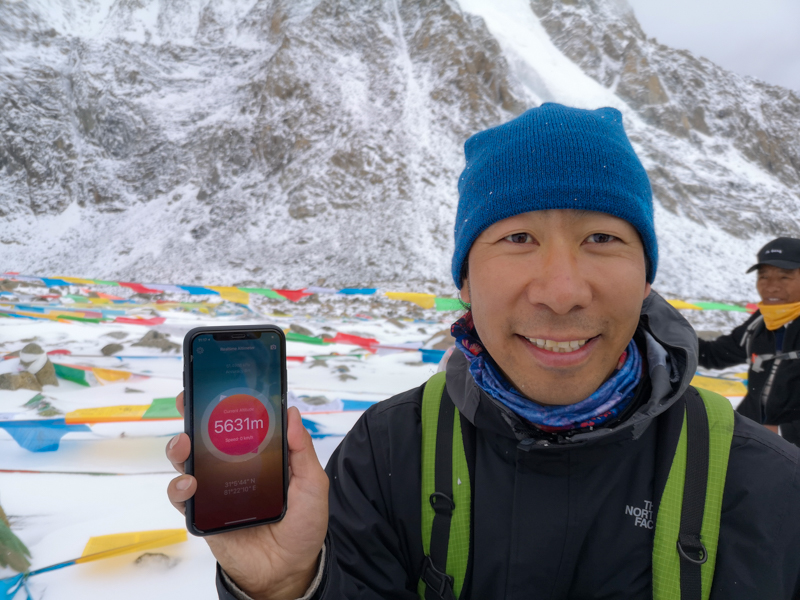
The founder of SnowLion Tours at Dolma La Pass during Mt. Kailash Trek in September 2018. As you can see the app indicates it is 5631m/ 18474ft at this very spot.
The need for oxygen at heights remains least the same. It is simply impossible to force the brain to consume less oxygen. And if we track, especially going up or with a heavy load, the body needs much more oxygen than during rest. It turns out, you need to get more oxygen from thinner air, while there is one and a half to two times less oxygen than on the plain. What can you do?
To accomplish this, every human has internal physiological mechanisms. Nothing is needed to be actually done: everything happens by itself. But there is one nuance. Only the simplest adjustments occur instantly: we start breathing more deeply, blood pressure and vascular permeability increase. In order to turn on more efficient mechanisms so that we could get oxygen without stress we need time. Until that happens, we suffer from side effects from those instant adjustments and the lack of oxygen when those mechanisms fail. Usually the first day and night at a higher altitude are painful and stressful, and the next day it is much better.
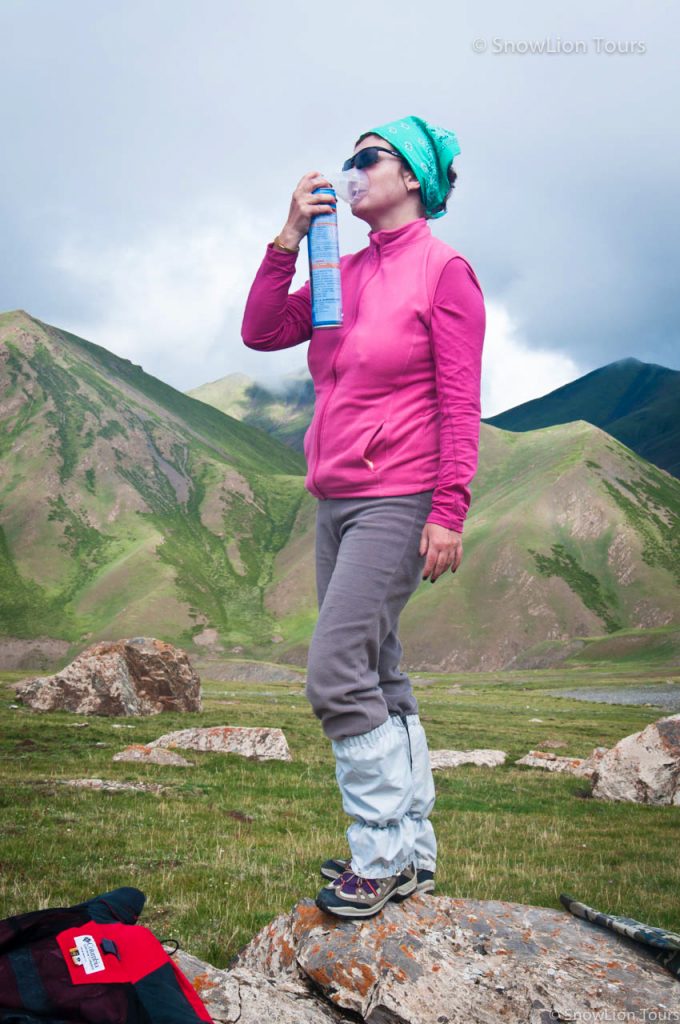
One of our client is using oxygen bottle during a trekking tour in Tibet
How to go to Tibet and not get mountain sickness?
1. The most important thing is to gain altitude gradually day by day. Above 2700 meters it is best to ascend no more than 500 meters in one day. In Tibet it is not always possible to follow such conservative scheme: there are simply no heights such small. Therefore, a reasonable minimum is to stay the first few days in Lhasa (3600 meters). There are hospitals there where mountain sickness can be treated, and in extreme cases, you can be quickly evacuated from the mountains. When ascending further than the height of Lhasa it is recommended to observe the schedule above;
2. In no case shall you ignore your state of health as well as others’. It is best that the trip includes a few spare days in case of health problems. Often even one day of rest from climbing saves the trip, and allows to continue next day, without the need to cancel the trip and be evacuated from the mountains.
With correct smooth acclimatization almost anyone can adapt to the heights of 5000-6000 meters and feel quite good after that: no problem walking even with a backpack, not suffering from insomnia, etc.
[On the way from Kailas to Lhasa]
Useful hints for the first days:
● Try not to eat too much, and mostly eat carbohydrates: pasta, rice, porridge, pastry. Proteins and especially fats are digested much slower. At first it is better to limit them and eat them mostly in the evenings. It is better to try Tibetan meat dishes later, when acclimatization is over and appetite appears;
● Carry and take micronutrients: potassium and magnesium (Trophicard, Panangin, Asparkam, etc.), 2-6 tablets per day. Those do not accelerate acclimatization, but are beneficial for muscles, including the heart;
● Rhodiola rosea extract (Chinese: 红景天Hong Jing Tian) is a natural-based stimulant that is often sold and used in Tibet that will help you feel better during the first days;
● Oxygen, sold everywhere in Tibet in disposable cans, helps to feel better and sleep in the first days;
● Some people drink Diamox (Acetazolamide) during the first days to relieve symptoms. NB: Diamox has side effects and if you want to take it preventively, consult your doctor and be sure to take it together with potassium (Trophicard, Panangin, Asparkam etc.);
● Headaches in the first days at moderate altitude can be eased with Aspirin. At high altitudes it is better to use Ibuprofen to avoid complications of mountain sickness due to blood dilution.
What is helpful for acclimatization:
● Reasonable physical activity (compared both to inactivity and overwork);
● Warm dry weather and regular warm drinks. At high altitude you will like sour drinks: oranges, lemons or citric acid, juices;
● Previous ascensions to the similar heights in the recent past. The more recent the ascension, the better residual acclimatization can help. But if it has been 2-3 months since, expectations of acclimatization are usually too far from reality;
● Individual metabolism. This is usually difficult to know in advance, but sometimes not even particularly athletic people adapt faster than their stronger companions.
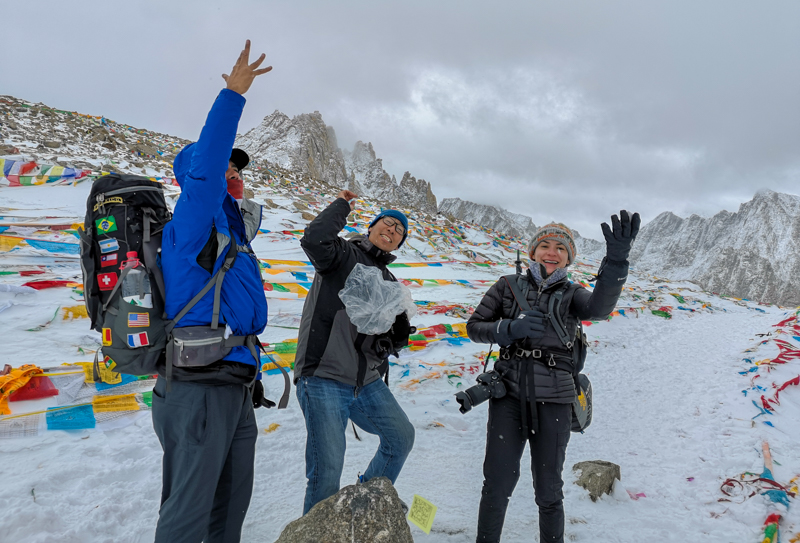
Our group is throwing Wind Horse or Longtar in the air to accumulate merits and wishing for the best for the rest of the Mount kailash Trek
What is harmful:
● Quick ascension by car, train, or plane: firstly, the body does not have enough time to adapt, and secondly, the person is usually inactive, which slows down adaptation;
● Lying down too much. Not only because of the immobility, but also due to peculiarities of blood circulation in the supine state. It is better to sit;
● Excessive loads causing nausea and severeheadaches. Moderate loads, which should not be avoided may cause shortness of breath, dizziness and weak headaches. The best way to assess the load and well-being is to consider previous experience at high altitudes. Worst of all is listening to others’ advices, unless they are doctors with experience in mountain sickness, and, oddly enough, your own ideas about your health: “I’m an athlete and will climb up faster than the others”;
● Alcohol;
● Cold, damp, too light clothes. Tibet is hot during sunny weather and very cold during cloudy weather, evenings, and nights;
● Catching up with the schedule, after taking Diamox and feeling better. When the effect of the medicine is over, the body is still at the high altitude, but it has not yet adapted to it. It’s dangerous.
What does not affect the speed of acclimatization:
● Medicine, herbs, food supplements, tea, coffee according to the research do not affect the speed of acclimatization. However, some mild stimulants and Acetazolamide (Diamox) may temporarily improve health;
● Previous ascensions to heights more than six months ago. However, high altitude experience helps to more distinguish harmless symptoms from dangerous more accurately and adjust the ascension schedule and physical activity;
● Oxygen in disposable bags: there is very little oxygen in them, and it does not affect the acclimatization and cannot help with acute mountain sickness (in mild cases, it may improve health).
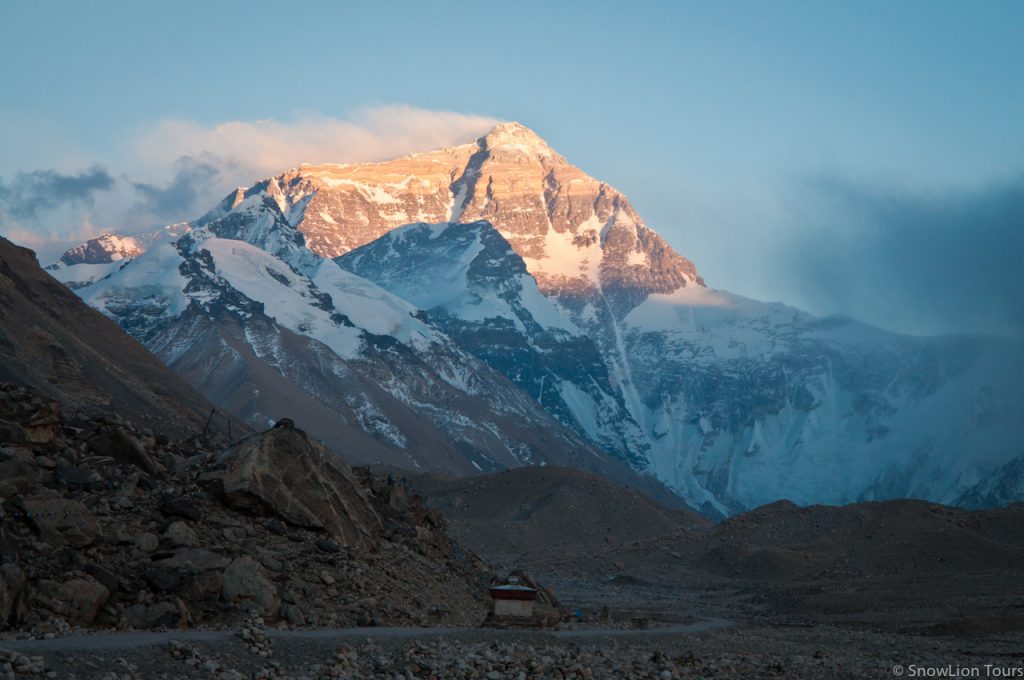
The world’s highest mountain – The Mount Everest during sunset from Northface.
How to recognize mountain sickness and assess its severity
|
Lake Louise Scoring System for Mountain Sickness |
|
|
Headache |
0 – No headache 1 – Mild headache 2 – Moderate headache 3 – Severe headache |
|
Gastrointestinal symptoms |
0 – None 1 – Poor appetite or nausea 2 – Moderate nausea or vomiting 3 – Severe nausea or vomiting |
|
Fatigue and weakness |
0 – Not tired or weak 1 – Mild fatigue/weakness 2 – Moderate fatigue/weakness 3 – Severe fatigue/weakness |
|
Dizziness and lightheadedness |
0 – Not dizzy 1 – Mild dizziness 2 – Moderate dizziness 3 – Severe dizziness, incapacitating |
|
Difficulty sleeping |
0 – Slept as well as usual 1 – Did not sleep as well as usual 2 – Woke many times, poor sleep 3 – Could not sleep at all |
|
Change in mental status (assessed by another person) |
0 – No change in mental status 1 – Lethargy /lassitude 2 – Disoriented/confused 3 – Stupor/semiconsciousness 4 – Coma |
|
Ataxia (heel to toe walking) |
0 – No ataxia 1 – Maneuvers to maintain balance 2 – Steps off line 3 – Falls down 4 – Can’t stand |
|
Peripheral edema |
0 – No peripheral edema 1 – Peripheral edema at one location 2 – Peripheral edema at two or more locations |
This is a common method fir assessment of mountain sickness, but it should be noted that many people, when trying to assess their condition themselves, overestimate the intensity of symptoms. For example, “severeheadache” here is a severeheadache that can interfere with, for example, falling asleep, but treatable with Ibuprofen or Aspirin.
1-2 points: no mountain sickness
3-5 points: mild mountain sickness, stay at the same height or descend
6 points and more: heavy mountain sickness, the condition may deteriorate itself even without ascending and carrying loads, and is life-threatening. Make sure to descend until the symptoms disappear. After 1-2 days of rest at a lower altitude you may ascend again, this time the condition will likely be much better.
|
Complications mountain disease – require immediate and descent to considerably lower altitude and hospital treatment |
|
|
High-altitude pulmonary edema |
Two or more of the following symptoms:
plus two or more of the following symptoms:
|
|
High-altitude cerebral edema |
2 or more points in each of “Change in mental status” and “Ataxia (heel to toe walking)” in the previous table |
[Using an oxygen can in Tibet]
How to get treatment
It’s best to descend as soon as possible to the altitude of previous stay where no symptoms of mountain sickness occurred. If it is Lhasa or another city, it is reasonable to visit a hospital — in Tibet they are are equipped specially to treat mountain sickness.
Before and during the descent it is recommended to use:
● Diamox (Acetazolamide) – 250 mg every 6-12 hours, main and well-known to be effective treatment. It has certain contraindications and side effects, but they are not as terrible as possible harm from acute mountain sickness. It is impossible to buy Diamox in Tibet and China: it is therefore recommended to bring it with you for prevention and treatment.
● Potassium/magnesium (Trophicard, Panangin, Asparkam, etc.) – 2-6 tablets per day. It is especially recommended if you take Diamox which removes potassium from the body.
● Ibuprofen – 400 mg 2-3 times a day as a painkiller, also in case of headaches.
● Dexamethasone 8 mg once, then 4 mg every 6 hours – only in case of complications of mountain sickness: pulmonary edema and brain edema.
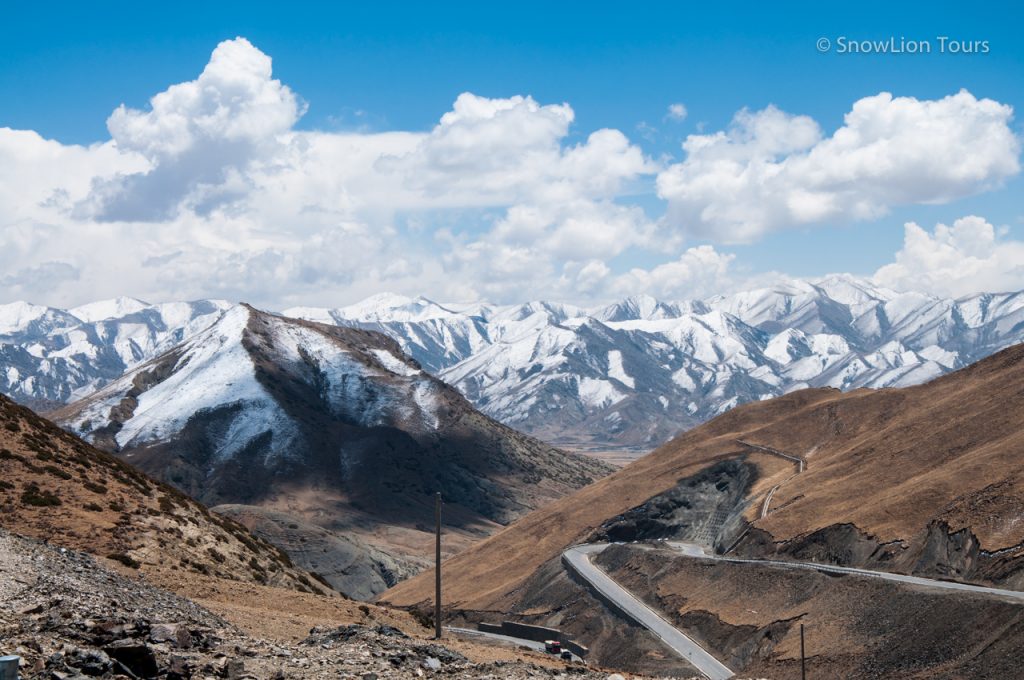
Some of the high places in Kham, eastern Tibet
In our experience the majority of foreign tourists coming to Lhasa and other high altitude places experience some symptoms of mountain sickness – headache, lack of appetite, mild nausea, insomnia, etc. This is absolutely normal and we recommend to prepare for possible discomfort during the first days of the tour. Our routes in Tibet are very well-designed, and the need for evacuation due to developing symptoms of mountain sickness is exceptionally rare, therefore, you do not need to worry too much before the trip, but it is recommended to bring basic first aid medicine just in case.
If you want to see what’s the altitude of your travel destinations, we have all elevations entered Tibetan Plateau is measured, please take a look at – Altitude in Tibet.
